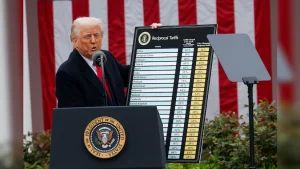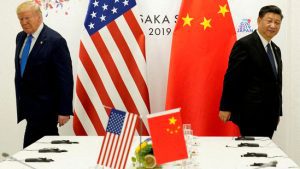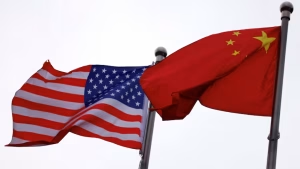Washington – In a dramatic escalation of the ongoing trade war, Donald Trump raised tariffs on China to an unprecedented 104 percent this Wednesday, fulfilling his earlier threat of imposing “additional 50 percent tariffs” on Chinese imports. This shocking development comes after China refused to withdraw its retaliatory 34 percent tariff on American goods within the 24-hour ultimatum issued by the White House.
Trump Administration Executes Historic Tariff Hike

When Donald Trump raised tariffs on China last week, few anticipated how rapidly the situation would deteriorate. The White House’s latest announcement marks the most aggressive trade action against Beijing in modern economic history, quadrupling the tariff rate that existed just one month ago.
“China has robbed and ripped off the US economy of billions and billions of dollars as a tariff abuser,” President Trump stated before implementing the new measures. The administration’s position reflects its long-standing grievance that Beijing has systematically exploited trade imbalances to America’s detriment.
The President’s decision to proceed with the tariff increase came just hours after Beijing officially rejected his ultimatum and vowed to “fight to the end” in this economic standoff. By the afternoon, Donald Trump raised tariffs on China despite warnings from economists about potential global market disruption.
The Rapid Progression from 10% to 104% Tariffs
The escalation timeline reveals how swiftly Donald Trump raised tariffs on China:
Until last month, Chinese imports faced a relatively modest 10 percent tariff rate. However, the Trump administration’s recent “reciprocal tariff” policy dramatically altered this landscape. Under this approach, the United States would apply approximately half the tariff rate that other nations impose on American goods. For China, this meant an additional 34 percent tariff, increasing their total rate to 44 percent.
Almost immediately following this announcement on April 2, the White House cited a “national emergency” stemming from security concerns related to persistent trade deficits. This declaration enabled the administration to implement a “baseline” 10 percent tariff on imports from all countries, pushing China’s cumulative tariff burden to 54 percent.
Today’s “additional 50 percent tariff” exclusively targeting China brings the total to an astonishing 104 percent—effectively doubling the cost of Chinese imports in less than a week’s time. When Donald Trump raised tariffs on China to this level, he established a new precedent in international trade relations that many analysts consider unprecedented.
Despite the harsh measures, President Trump has indicated he remains open to negotiations. On his Truth Social platform, he wrote: “China also wants to make a deal, badly, but they don’t know how to get it started. We are waiting for their call.”
China’s Defiant Response
Beijing’s reaction to the tariff increases has been unequivocal. When Donald Trump raised tariffs on China initially, Chinese officials expressed strong disapproval. As the situation intensified, their rhetoric hardened considerably.
In response to the President’s ultimatum demanding withdrawal of China’s retaliatory 34 percent tariff, China’s commerce ministry issued a scathing statement: “The US threat to escalate tariffs against China is a mistake on top of a mistake, which once again exposes the US’s blackmailing nature.”
The statement continued with a direct challenge to Washington: “If the US insists on having its way, China will fight to the end.” This resolute stance suggests that Beijing has no intention of capitulating to American pressure, even as Donald Trump raised tariffs on China to levels that could severely impact its export-driven economy.
Economic analysts note that China has several retaliatory options at its disposal, including further tariff increases on American goods, devaluation of the yuan, restrictions on rare earth mineral exports crucial for technology manufacturing, and potential disruption of supply chains for American companies operating in China.
Impact on Specific Industries and Supply Chains
The ripple effects of these tariff increases will be felt differently across various sectors. When Donald Trump raised tariffs on China, certain industries became particularly vulnerable. The consumer electronics sector, heavily dependent on Chinese manufacturing and components, faces immediate challenges. Companies like Apple, Dell, and Microsoft may need to either absorb significant cost increases or pass them on to consumers, potentially dampening demand for their products.
The textile and apparel industry, which has gradually been shifting production away from China to Vietnam, Bangladesh, and other lower-cost countries, will likely accelerate this transition. However, such relocations require time and investment, meaning short-term price increases for American consumers are virtually inevitable.
Retailers like Walmart, Target, and Amazon, which source vast quantities of consumer goods from China, now face difficult decisions about inventory management, pricing strategies, and supplier relationships. The National Retail Federation estimates that the average American household could face additional costs of $1,000 to $2,500 annually due to these tariff increases.
“When Donald Trump raised tariffs on China to this extent, he essentially forced every retail business in America to completely reevaluate their supply chain strategy overnight,” explained Marcus Rivera, chief economist at the American Consumer Institute. “The question isn’t whether prices will increase, but rather by how much and how quickly.”
Global Market Reaction and Economic Implications
Financial markets have responded dramatically to the news that Donald Trump raised tariffs on China. Major indices worldwide experienced their steepest declines since the COVID-19 pandemic, reflecting investor anxiety about the potential repercussions of an intensified trade war between the world’s two largest economies.
The Dow Jones Industrial Average plummeted over 800 points in early trading, while European and Asian markets similarly recorded significant losses. The Chinese Shanghai Composite index dropped 4.2 percent, marking its worst single-day performance in nearly three years.
Economists warn that when Donald Trump raised tariffs on China to 104 percent, he potentially triggered a chain reaction that could disrupt global supply chains, accelerate inflation, and hamper economic growth worldwide. American consumers may face substantially higher prices for everyday goods, while manufacturers dependent on Chinese components could experience production delays and increased costs.
Dr. Emily Chen, senior economist at the Global Trade Institute, explained: “When Donald Trump raised tariffs on China to this extent, he essentially imposed a massive tax on American businesses and consumers. While the administration frames this as punishment for China, economic research consistently shows that tariffs are primarily paid by the importing country’s citizens and businesses.”
The agriculture sector, which has already weathered significant challenges from previous rounds of tariffs, faces renewed uncertainty. When Donald Trump raised tariffs on China during his first term, Beijing retaliated by targeting American agricultural exports, particularly soybeans, causing substantial hardship for farmers in the Midwest. Many fear a repeat of this scenario, despite the administration’s promises of compensation through subsidies.
Currency Markets and International Finance
The foreign exchange markets have reacted strongly to the latest developments. The Chinese yuan depreciated significantly against the dollar immediately after Donald Trump raised tariffs on China, a move that partially offsets the tariff impact for Chinese exporters by making their goods relatively cheaper in dollar terms.
This currency adjustment has raised concerns about potential currency manipulation accusations from Washington, which has long criticized Beijing’s management of the yuan. Treasury Secretary indicated that the department is “closely monitoring” China’s currency practices in light of recent market movements.
International financial institutions have expressed concern about the potential for broader economic contagion. The IMF released a statement urging both nations to “exercise restraint and return to dialogue,” warning that a protracted trade conflict between the world’s largest economies could reduce global GDP by up to 0.8 percent in the coming year.
Bond markets have reflected growing economic uncertainty, with yields on U.S. Treasury securities falling as investors seek safe-haven assets. This flight to safety signals serious concerns about global economic stability in the wake of these unprecedented tariff increases.
Historical Context and Comparison


While Donald Trump raised tariffs on China throughout his first administration, the current escalation represents a significant intensification of his “America First” trade policy. During his 2017-2021 term, tariffs on Chinese goods reached approximately 19 percent on average—high by historical standards but nowhere near the current 104 percent rate.
Trade historians note that such punitive tariff levels haven’t been seen since the early 20th century. The infamous Smoot-Hawley Tariff Act of 1930, which raised duties on thousands of imported goods to record levels during the Great Depression, is frequently cited as a cautionary tale about the potential dangers of protectionist trade policies.
“When Donald Trump raised tariffs on China to these levels, he entered territory not seen in modern economic history,” said Professor James Wilson, an economic historian at Georgetown University. “The Smoot-Hawley tariffs averaged about 45 percent across all imports. What we’re seeing now with China-specific tariffs at 104 percent is unprecedented in our contemporary globalized economy.”
Regional Trade Implications and Geopolitical Considerations
The tariff conflict has significant implications for regional trade architecture in Asia. Since Donald Trump raised tariffs on China, neighboring economies like Vietnam, Malaysia, and Thailand have experienced increased investment as manufacturers seek to diversify production away from China. This trend, already underway during the previous administration, will likely accelerate dramatically.
Japan and South Korea find themselves in particularly delicate positions, balancing their security alliances with the United States against their economic integration with China. Both nations have carefully avoided taking explicit sides in the dispute, though their export-oriented economies remain vulnerable to disruptions in global trade patterns.
The European Union, meanwhile, continues to pursue its own trade agenda with both superpowers. EU Trade Commissioner remarked that when Donald Trump raised tariffs on China, he created “both challenges and opportunities” for European businesses. While some EU manufacturers may benefit from reduced Chinese competition in the American market, the overall economic uncertainty and threat of trade diversion remain concerns for European policymakers.
India has cautiously positioned itself to potentially benefit from manufacturing relocation, with government officials highlighting recent infrastructure investments and business-friendly reforms. “When Donald Trump raised tariffs on China, he accelerated a process of supply chain diversification that could benefit multiple developing economies,” noted Dr. Rajiv Menon, Senior Fellow at the Delhi Economic Forum.
Strategic Objectives Behind the Tariff Increase
The Trump administration has articulated several strategic objectives behind its tariff policy. When Donald Trump raised tariffs on China, administration officials cited national security concerns, intellectual property theft, unfair trade practices, and the persistent trade deficit with Beijing.
“For too long, China has taken advantage of America through unfair trade practices, currency manipulation, and intellectual property theft,” stated Commerce Secretary during a press briefing. “President Trump’s decisive action sends a clear message that the United States will no longer tolerate economic aggression and exploitation.”
Critics argue that while these concerns have merit, the tariff approach may be counterproductive. When Donald Trump raised tariffs on China previously, studies indicated mixed results in terms of reshoring manufacturing jobs or significantly reducing the trade deficit. Instead, many American companies simply redirected their supply chains through other Asian countries while continuing to source materials from Chinese suppliers.
The administration’s willingness to use tariffs as leverage represents a fundamental shift in American trade policy that began during Trump’s first term and has now accelerated dramatically. When Donald Trump raised tariffs on China this time, he signaled a continued preference for bilateral negotiations backed by economic pressure rather than multilateral engagement through institutions like the World Trade Organization.
Technology Sector and National Security Nexus
The intersection of trade policy and national security concerns becomes particularly evident in the technology sector. When Donald Trump raised tariffs on China, he specifically targeted categories of goods with strategic significance, including semiconductors, advanced manufacturing equipment, and telecommunications infrastructure.
Administration officials have repeatedly framed these tariffs as necessary to protect America’s technological edge and prevent industrial espionage. The Commerce Department simultaneously expanded restrictions on technology exports to China, particularly in fields like artificial intelligence, quantum computing, and advanced semiconductor manufacturing.
American technology companies face complex challenges navigating this environment. While some benefit from reduced Chinese competition in the domestic market, many depend on global supply chains and access to China’s massive consumer market. Industry groups have expressed concern that when Donald Trump raised tariffs on China, he potentially triggered retaliatory measures that could harm America’s technological competitiveness.
Chinese officials have denounced the security justifications as pretexts for economic protectionism. “The United States uses national security as an excuse to suppress Chinese technology companies,” stated a foreign ministry spokesperson. “This represents a dangerous politicization of normal economic and technological cooperation.”
Potential Paths Forward

Despite the escalation, diplomatic channels remain open. When Donald Trump raised tariffs on China, he simultaneously expressed willingness to negotiate, suggesting that the extreme measures might be intended primarily as leverage to force concessions from Beijing.
Several scenarios could unfold in the coming weeks:
- China could capitulate and agree to American demands, though this appears unlikely given their public statements and historical reluctance to appear weak in international negotiations.
- Both sides might agree to resume talks, potentially resulting in a temporary tariff reduction while negotiations proceed.
- China could implement retaliatory measures beyond tariffs, potentially targeting American companies operating within China or restricting exports of critical materials.
- The situation could further deteriorate, with Donald Trump raising tariffs on China even higher and Beijing responding in kind, potentially triggering a full-scale economic conflict with global repercussions.
Economic advisors within the administration have reportedly proposed a framework for potential resolution that would involve China committing to significant purchases of American goods, enhanced intellectual property protections, and greater market access for U.S. companies. Whether such proposals gain traction remains uncertain.
Domestic Political Implications
The timing of these tariff increases has significant domestic political implications. When Donald Trump raised tariffs on China so dramatically just months into his second term, he demonstrated his commitment to the economic nationalist platform that helped secure his electoral victory.
The move has garnered support from both traditional manufacturing constituencies and national security hawks concerned about Chinese economic influence. Labor unions in rust belt states have generally supported aggressive trade measures against China, while agricultural interests remain more ambivalent given their reliance on export markets.
Congressional reactions have largely fallen along partisan lines, with Republicans supporting the President’s decision and Democrats criticizing both the tariff approach and its implementation. Senate Majority Leader described the move as “a necessary step to protect American workers,” while the House Minority Leader countered that “reckless tariff wars hurt American consumers more than they help American producers.”
Long-term Economic Considerations
Economists remain divided on the long-term implications of these unprecedented tariffs. When Donald Trump raised tariffs on China to 104 percent, he effectively decoupled significant portions of the world’s two largest economies, a process some strategists have advocated but whose consequences remain largely theoretical.
Proponents of the approach argue that short-term pain will yield long-term benefits by forcing American businesses to develop more resilient and diversified supply chains less dependent on China. Critics counter that the abrupt nature of the changes could cause unnecessary economic damage without achieving strategic objectives.
What remains clear is that when Donald Trump raised tariffs on China to these historic levels, he fundamentally altered the economic relationship between Washington and Beijing in ways that will reverberate throughout the global economy for years to come.
Environmental and Labor Standards Considerations
An often-overlooked dimension of the trade conflict involves environmental and labor standards. Advocates of tariffs argue that when Donald Trump raised tariffs on China, he indirectly addressed the competitive disadvantage American manufacturers face due to China’s less stringent environmental regulations and labor practices.
Environmental organizations have expressed mixed reactions. Some acknowledge that relocating production from China could potentially reduce global carbon emissions if manufacturing shifts to countries with stricter environmental standards. Others worry that economic pressure could lead China to prioritize short-term growth over environmental commitments.
Labor advocates in both countries face similar dilemmas. American unions generally support measures that protect domestic manufacturing jobs, while human rights organizations express concern that economic hardship in China could exacerbate labor exploitation as manufacturers struggle to maintain profit margins despite tariff burdens.
“When Donald Trump raised tariffs on China, he created an opportunity to rethink global production standards,” noted Dr. Sarah Johnson of the International Labor Rights Forum. “However, without explicit conditions related to worker protections and environmental safeguards, tariffs alone won’t necessarily lead to more sustainable or equitable outcomes.”
Closing Remarks
The decision of USA to impose 104 percent tariffs on Chinese imports represents the most dramatic escalation yet in the ongoing economic conflict between the United States and China. When Donald Trump raised tariffs on China to this unprecedented level, he signaled an unwillingness to return to the pre-2017 trade relationship that many American policymakers view as having disproportionately benefited Beijing.
As markets adjust to this new reality and both nations consider their next moves, the international community watches with apprehension. The outcome of this confrontation between the world’s economic superpowers will likely shape global trade patterns, supply chains, and diplomatic relations for decades.
The coming weeks will reveal whether this extreme measure succeeds in bringing China to the negotiating table on terms favorable to American interests, or whether it instead accelerates the fragmentation of the global economic order into competing spheres of influence. What’s certain is that when Donald Trump raised tariffs on China, he initiated a high-stakes economic gambit whose full consequences remain to be seen.

